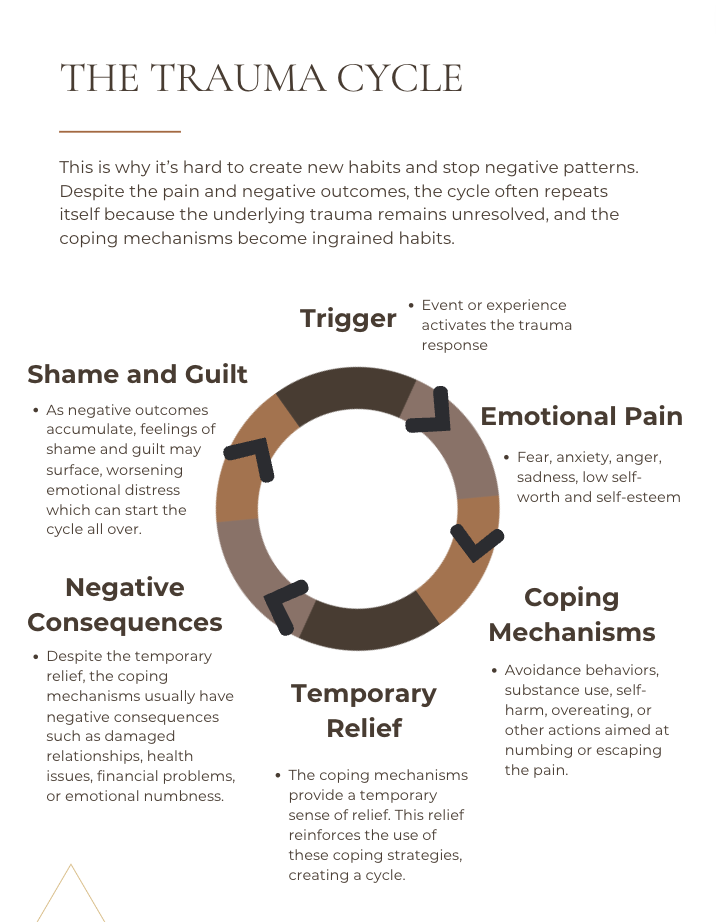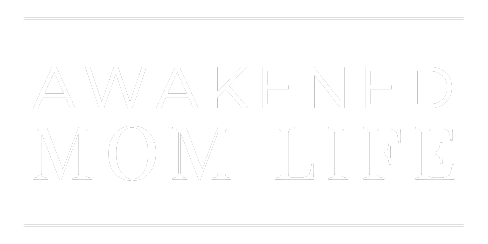Have you ever wondered why you keep doing things when they cause pain? Why do I eat a whole pint of ice cream after fighting with my husband over money again? Why do I keep returning to a relationship with a family member when they do not reciprocate support and care? You’re not alone. Trauma creates a pattern that becomes embedded into your brain and body. Once you understand the pattern, you can begin to break the trauma cycle.

The Trauma Cycle
1. Triggering the Trauma Cycle
It all starts with a trauma trigger—a reminder of past trauma that sets off a cascade of intense emotions. This trigger can be entirely subconscious. It could be a conversation, a person, a place, or even a fleeting thought that sends your mind into distress.
2. Escaping the Pain
In response to these overwhelming emotions, we often develop maladaptive (unhealthy) coping mechanisms. These can range from avoidance behaviors and substance use to self-harm or overeating—anything to numb the pain temporarily and escape the intensity of our feelings.
3. Temporary Relief
Initially, these coping mechanisms may provide temporary relief or distraction. They offer a momentary pause from the emotional turmoil raging inside, allowing us to find peace in moments of chaos. However, the temporary relief and the pleasure we feel from these coping mechanisms, which is caused by chemicals like dopamine and endorphins in our brain, can make it difficult to break free from these unhealthy habits and find more adaptive ways of coping.
Dopamine, known as the brain’s ‘feel-good’ chemical, provides a sense of pleasure and reward. Similarly, endorphins act as natural painkillers, creating a euphoric sensation that momentarily alleviates emotional distress. These chemical reactions reinforce the use of maladaptive coping strategies because we like to feel good. Our brain wants more happy chemicals, even if it means doing something repeatedly that leads to pain.
4. Consequences of Coping
The relief we feel is short-lived, and the coping mechanisms come with their own set of consequences. They can strain relationships, harm our health, create financial burdens, and leave us feeling even more isolated and disconnected.
That pint of ice cream we eat every time we get into an argument leads to weight gain and high cholesterol. These hormone imbalances lead to inflammation, and inflammation can lead to autoimmune disorders. See the cycle?
5. Shame and Guilt
As the negative consequences pile up, we start to feel a deep sense of shame and guilt. We feel stuck and blame ourselves for our actions, believing that if only we were stronger or better, we wouldn’t keep doing the same thing repeatedly.
6. Repeating the Pattern
Despite the pain and the knowledge of the harm it causes, we often repeat the same patterns because we are trying to fight our biology and usually won’t win that way. The trauma cycle continues, fueled by unresolved trauma and reinforced by the temporary relief our coping mechanisms provide.

Understanding the roots of this trauma cycle and addressing the underlying trauma is essential to break free.
Breaking Free from the Cycle of Trauma
Breaking free from the emotional trauma cycle is not easy, but it is possible. It requires courage, self-compassion, and a willingness to confront the pain we’ve been trying to avoid. It’s about reclaiming our power and rewriting our story—not as victims of our past, but as survivors reclaiming our present and future.














